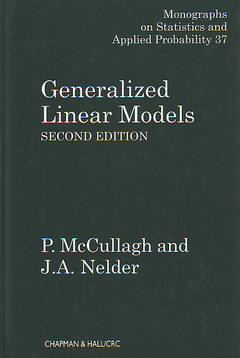Generalized Linear Models (2nd Ed.) Chapman & Hall/CRC Monographs on Statistics and Applied Probability Series
Auteur : McCullagh P.

The success of the first edition of Generalized Linear Models led to the updated Second Edition, which continues to provide a definitive unified, treatment of methods for the analysis of diverse types of data. Today, it remains popular for its clarity, richness of content and direct relevance to agricultural, biological, health, engineering, and other applications.
The authors focus on examining the way a response variable depends on a combination of explanatory variables, treatment, and classification variables. They give particular emphasis to the important case where the dependence occurs through some unknown, linear combination of the explanatory variables.
The Second Edition includes topics added to the core of the first edition, including conditional and marginal likelihood methods, estimating equations, and models for dispersion effects and components of dispersion. The discussion of other topics-log-linear and related models, log odds-ratio regression models, multinomial response models, inverse linear and related models, quasi-likelihood functions, and model checking-was expanded and incorporates significant revisions.
Comprehension of the material requires simply a knowledge of matrix theory and the basic ideas of probability theory, but for the most part, the book is self-contained. Therefore, with its worked examples, plentiful exercises, and topics of direct use to researchers in many disciplines, Generalized Linear Models serves as ideal text, self-study guide, and reference.
Date de parution : 08-1989
Ouvrage de 512 p.
15.2x22.9 cm
Thème de Generalized Linear Models :
Mots-clés :
Generalized Linear Models; Initial White Blood Cell Count; Inverse Linear Models; Log Linear Model; Linear Predictor; Cumulative Distribution Function; Extended Quasi-likelihood; Deletion Residuals; Log Likelihood Derivative; Normal Theory Linear Model; Inverse Fisher Information Matrix; Model Formula; Classical Linear Models; Complementary Log Log Link; Gamma Errors; Link Functions; Complementary Log Log; Quasi-likelihood Estimates; Proportional Odds Model; Half Normal Plot; Higher Order Cumulants; Variance Function; Partial Residual Plot; Non-linear Parameters; Conditional Log Likelihood



